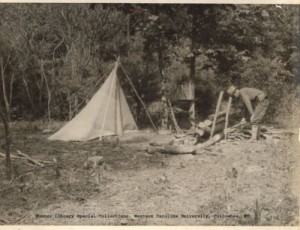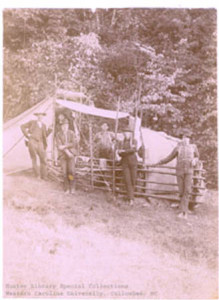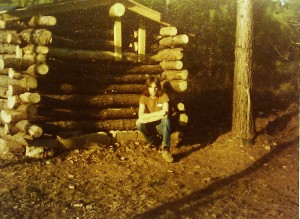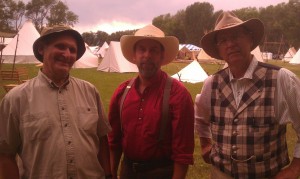Recently I have been thinking about the connections among outdoor skills, camping and the concept of “wilderness.” What are these connections and what do they mean for those of us that enjoy practicing a wide variety of outdoor skills (for lack of a better catch-all term), including Bushcraft, Woodsmanship, Woodcraft, or whatever they may be called? Many of these skills are our shared outdoor heritage, handed down from a variety of sources, from native peoples to the “old masters” like Seton, Beard and Kephart.

Camp Toco, Kephart’s fixed camp in the Smokies. (Photo: Hunter Library, Western Carolina University, Cullowhee, NC)
These skills belong to anyone who puts in the blood, sweat and dirt time to learn them. They are no one’s exclusive property. No one person or group can “own” these skillsets to the extent of excluding others who have learned skills contained within them. Once the skills are learned, if someone wants to use them in the wilderness, in a backyard, in a parking lot, or even to make money, then so be it. Another point to be considered is that some of us have the idea that to practice these skills, and to “keep it real,” we have to be in the wilderness. It is as if when these skills are not presented as being taught “in the wilderness” it somehow invalidates or cheapens the skills or information presented. The way that we view the concept of wilderness, the frontier ideal, the feelings it evokes, how it has evolved, and how it, as a part of our consciousness, continues to surface even today, is a very interesting subject. William Cronon’s excellent and thought-provoking essay, The Trouble With Wilderness, or Getting Back to the Wrong Nature, which I quote later in this article, is a must read for everyone still reading this.
Cronon’s essay is available here in its entirety
Cronon makes several important points in this work that are relevant to our discussion. One idea is that the attitude that Americans have today about the wilderness as something worthy of reverence and protection is a very recent development. Before the nineteenth century, the wilderness was a place of savagery, a place of banishment, an undesirable place that should be controlled and from which civilization should be wrested. But nineteenth century romantics like Wordsworth, Thoreau, and later Muir and Fredrick Jackson Turner, brought about a change in attitude with regard to the concept of wilderness and its connection to the “vanishing frontier” of the 1800’s.
“The removal of Indians to create an “uninhabited wilderness”-uninhabited as never before in the human history of the place -reminds us just how invented, just how constructed, the American wilderness really is. To return to my opening argument: there is nothing natural about the concept of wilderness. It is entirely a creation of the culture that holds it dear, a product of the very history it seeks to deny.” — The Trouble with Wilderness; or, Getting Back to the Wrong Nature by William Cronon
The whole idea that the frontier is vanishing and that what is left of it must be protected so that people can go out and prove themselves in the “wilderness” is an invention and vestige of nineteenth century romanticism that permeates our national psyche to this day. As proof, just look at the titles of television programs such as Man vs. Wild, Naked and Afraid, Survivor, Wild Alaska, Dual Survival, Mountain Men and the list goes on. This is not to say that parks and wilderness areas shouldn’t exist today-they should. Nevertheless, as Cronon implies, when people start to believe in this wilderness ideal, it is, in a way, self-defeating. The wilderness by definition is supposed to be devoid of people and their impact. If we go there, especially when a lot of us go (as we do in droves to our national parks), it’s not the wilderness anymore, and it is impossible to “leave no trace.” Most importantly, attitudes such as these indicate that we somehow believe we stand apart from nature, when in actuality, we are a part of it, whether it is in our own backyard or not. This kind of thinking leads people to burn large quantities of fossil fuel driving hundreds of miles to the trailhead, only to camp within earshot of traffic noise, see hordes of other “wilderness” sojourners, or hear rangers tell them they should consider not coming on the weekend next time. It is the same attitude that prevails in the idea of “wilderness” survival-the idea that somehow, with ingenuity and a modicum of “modern” equipment, we can, incredibly, survive our own environment! Nature is everywhere, not just in the wilderness. This fact is the true embodiment of environmental responsibility.
What we sometimes fail to realize is that the sublime we so often seek in this wilderness ideal can be found in our own backyards or in other nearby places. Witness the following quote:
“Camping has no great popularity today because men have the idea that it is possible only after an expensive journey to the wilderness; and women that it is inconvenient, dirty, and dangerous. These are errors. They have arisen because camping as an art is not understood. When intelligently followed, camp life must take its place as a cheap and delightful way of living, as well as a mental and physical savior of those strained or broken by the grind of the overbusy world. The wilderness affords the ideal camping, but many of the benefits can be got by living in a tent on a town lot, a piazza, or even a housetop.” — Ernest Thompson Seton, The Book of Woodcraft, 1912
A camp need not be in the wilderness for a camper to enjoy the outdoors. If the backyard is not remote enough, a fixed camp can be set up on a large tract of private land far out in the quiet of the country for a week or more. During this time, many of the same skills one would need in the wilderness can be put to use. Hunting, trapping, preservation of meat, fire and sheltercraft, properly pitching camp to weather storm conditions, camp cookery, manufacturing tools, making furniture and other endeavors connected with making one’s way in the outdoors can all be practiced.

A packable classic camp. Kephart’s tent is most likely ballon silk (Egyptian cotton). (Photo: Hunter Library, Western Carolina University, Cullowhee, NC)
“When camp is made in a certain locality with no intention of moving it until the party is ready to go home, it is usually called a “permanent camp.” This is a misuse of terms; for a camp of any kind is only a temporary biding place. “The camp and not the soil,” says Gibbon, “is the native country of the genuine Tartar.” When speaking of a camp fixed in one place for a considerable time I shall call it a “fixed camp.” It differs from a “shifting camp” in permitting more comforts of home.” — Horace Kephart, Camping and Woodcraft
Fixed camps with or without large canvas tents can be set up anywhere it is legal to do so and where one desires to partake of the benefits of life in the open. Fixed camps equipped with canvas wall tents may be set up miles from the nearest road. Once the trailhead is reached, roads, vehicles and parking lots are not required for the establishment of a fixed camp with canvas wall tent, awning and other basic comforts. Wall tents have been transported and pitched for hundreds of years by soldiers, miners, hunters and others making a living in wilderness areas lacking roads.

Kephart’s first classroom in the Smokies. The fence was to keep wild hogs out. The smaller canvas structure to the right was his pantry. (Photo: Hunter Library, Western Carolina University, Collowhee, NC)
Take out the hunting and trapping and the same skills can be utilized in many backyards. It is not necessary to go to the wilderness to pitch a tent, cook outside without utensils, start a fire without matches or practice many other outdoor skills.
Another very important point that I think is often missed is that no matter what one calls these outdoor skills, Woodcraft, Woodsmanship and Bushcraft are not styles of camping, they are sets of skills. Car camping, backpacking, canoe camping and Classic Camping and its variations are types of camping, not skillsets. Skillsets represent specific knowledge or information. Both Mears and Kochanski allude to this fact in the beginning of their books. For example, from what I have seen, those who use the skillset most would call Bushcraft are practicing a type of camping I would call backpacking or canoe camping. Classic Campers mainly tap into Woodcraft as practiced by Horace Kephart and Dan Beard, with a bit of modern technology, like how to use a Primus, thrown in. A day trip is simply a hike, canoe trip or what have you, rather than a type of camping, but its not a skillset. This is one of the main places where people are getting hung up in discussions on the Internet and unnecessarily coming into conflict. The skillset you use and the kind of camping you do are two different things. No matter what you call it, the skillset is not the kind of camping that you do. The kind of camping you do determines the skills you need. Some of these skills overlap and appear in several skillsets. An example is sharpening. It doesn’t matter what kind of camper you are, sharpening is a skill you need. It fits into the skillsets of Bushcraft, Woodcraft, Woodsmanship or whatever you want to call it. It’s the same with laying a fire or using a kerosene stove.
Sometimes I go out to the country and go camping, not to consciously practice skills, but just to enjoy the peace and quiet. I call this Woods Loafing-or as my friend and fellow woods bum Wayne Williams calls it, “loafering around.” If I had to depend on being able to go to an actual wilderness to go camping, I would be in trouble. I don’t have the finances or time to mount a wilderness excursion, not even once a year. By wilderness, I am not speaking of National Parks, National Forests or preserves of any kind, or of anywhere in the Eastern US, as by definition, these could hardly be considered true wilderness the way that certain parts of Alaska and Canada can. I enjoy many kinds of camping, and have done my share in parks and wilderness areas, but these days what I enjoy most is Classic Camping on private land, moving my gear by car or canoe. I like camping on private land because it offers security, privacy and the freedom to do what I want within the confines of good stewardship. I don’t have to worry as much about running into ne’er do wells on the trail, leaving my gear unattended while I hike, being seen while answering the call of nature, cutting a tree or two, gumming a rabbit for a stew or a host of other concerns I would worry about in a designated “wilderness area” in the eastern US.
I have a friend named John who has camped in various places around the world. He even lived with natives in the South Seas for a while. John is famously known as the “Backyard Camper” because he once pitched his canvas wall tent in his backyard and left it set up for a year, sleeping in it every night he could and practicing his skills. Knowing John, it was more often than not that he spent the night out there. Think of what John learned during that year and how many times he got to camp! The sublime is right under our noses. Enjoy nature and practicing your skills and sharing them with others, wherever you are, whatever those skills may be. It is a great thing if some of them are, but you needn’t worry if all your camping trips aren’t to the “wilderness.”
“A person with a clear heart and open mind can experience the wilderness anywhere on earth. It is a quality of one’s own consciousness. The planet is a wild place and always will be.” — Gary Snyder, quoted from The Trouble with Wilderness; or, Getting Back to the Wrong Nature by William Cronon
For further reading, please read The Practice of the Wild, by Gary Snyder. Steve Watts turned me on to this book. It comes highly recommended by both of us.
Author Biography:
Tom Ray, 53, grew up on a small farm near Lockhart, South Carolina. His youth was spent hunting, fishing, camping and trapping in and around the Broad River Basin and Sumter National Forest. As a result, he developed a lifelong interest in history, aboriginal studies, survival, primitive arts and frontier life. Early teachers were his older brother James and his Uncle, Grover Pinkney “Pink” Scott. For the last sixteen years, he has studied with Steve Watts at the Schiele Museum of Natural History. Another very important teacher is Errett Callahan. Other teachers and influences include David Wescott, Mel Deweese, Mors Kochanski and Dave Holladay. For the past 28 years, Tom has worked in private, public and technology education. He has taught numerous primitive skills classes and has presented a multitude of interpretive programs to a wide audience. His works have been published in the Bulletin of Primitive Technology and on masterwoodsman.com. He and his wife Claudia reside in Rock Hill, SC.






5 Responses to The Jumping Off Place: The Relationship of Outdoor Skills and Camping to the Concept of Wilderness by Tom Ray